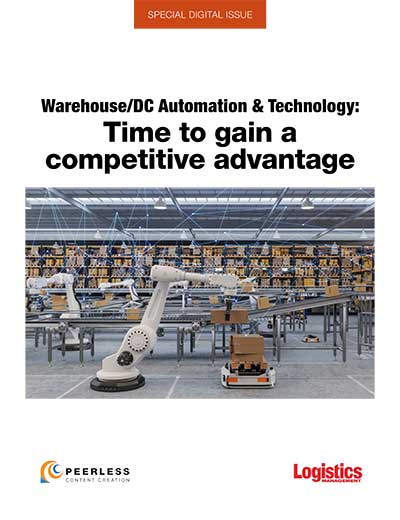Inside the modern vertical farm
Through the use of automation, software and sensor technologies, Bowery Farming is disrupting the traditional agriculture supply chain.
Bowery Farming
Location: Bethlehem, Pa.
Size: 150,000 square feet
Products: Leafy greens and herbs
Read the related feature article on the Bowery Farming operation.
What does modern farming look like? Like e-fulfillment, it starts with getting close to the customer to ensure freshness. Bowery Farming’s facilities are located within about 400 miles of the stores it is servicing. Transparency also comes into play, as each product lists where it was grown.
A second aspect of the operations related to freshness is to eliminate storage of the product for longer than necessary: Greens and herbs are shipped as soon as possible after they are harvested and packaged.
Another unique aspect is that Bowery Farming is not subject to the weather and the seasons as with traditional farming. Frankert declines to say just how many crops a farm can grow in a year, cycle times are proprietary, but they are accelerated, and the farms can grow year around.
The process starts in a seeding and germination room (1), where seeds are planted and begin to germinate. Once they reach a certain stage, or grow pattern, the plants are moved into an irrigation room (2) for density. And then, once they hit the next maturity level, the seedlings are placed onto one of the 4-foot by 8-foot aluminum trays and inducted onto a conveyor system. From there, automation takes over.
Once a tray enters the automated storage and retrieval system (AS/RS) (3), it is picked up by a lift that will take it to the right level. It will then be transferred by a carrier that can move to any storage location on a level. Once the tray is in place, it receives a recipe of light, temperature and water—no pesticides or insecticides are used in the process. The system has the capability to adjust all three at the storage location level: For instance, a tray growing at 68 degrees might be stored right next to another tray where the temperature is 70 degrees.
The plant growth is monitored by the system; a plant that is progressing outside of the projected growth rate can be moved to another location to receive a different recipe. Lifts and carriers operate every day of the week.
Once a plant is at its peak, it exits the AS/RS and is transferred to the processing room (4), where automatic equipment handles the harvesting. The raw material is then moved to a packing area (5) where the recently harvested plants are cooled, packed, labeled and inspected.
If they pass inspection, the vegetables and herbs are boxed, palletized and briefly staged in the warehousing area (6) for delivery to grocery stores in dedicated trucks. Delivery is typically within 2 days of harvesting.

System Supplier
The farm operating system, warehouse management, warehouse execution system and automated storage and retrieval system were all designed by Bowery Farming.













